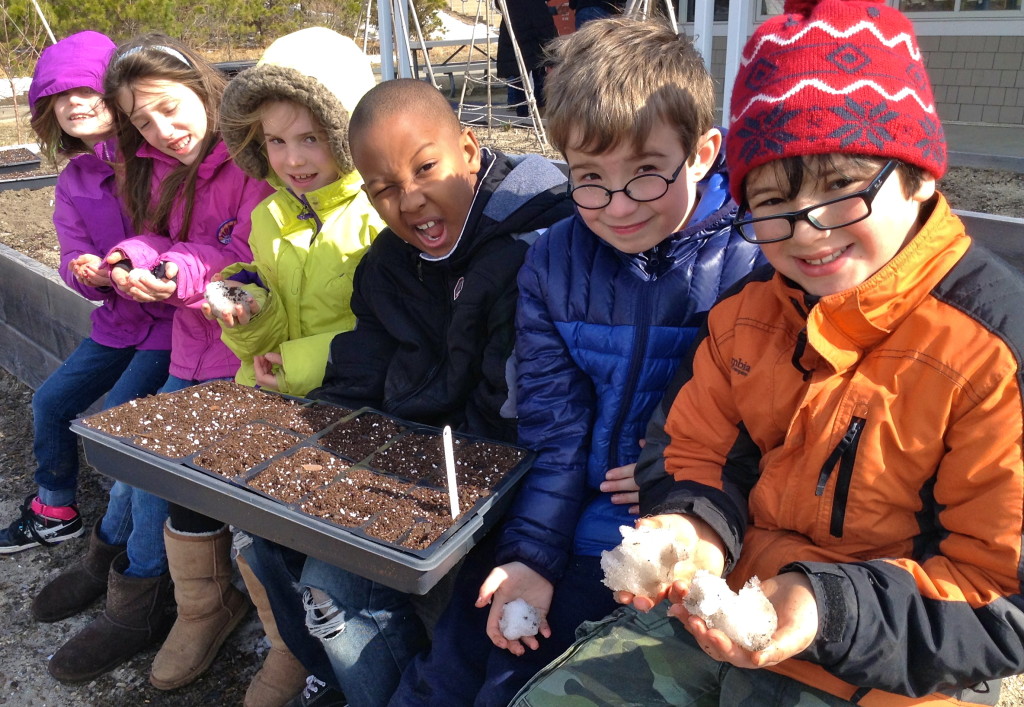IN AN (ORGANIC) NUTSHELL
Envisioning Change
Our premise is simple. We’ve seen that if kids grow food, they’ll try it and eat the goodness they’ve grown. Yes to spinach. Yes to pea shoots, to carrots, to edible flowers. Yes to kale chips!
It’s this enthusiasm for getting outside in the dirt, for starting with a seed and patiently tending, observing, measuring, documenting and… finally!… harvesting and eating that makes gardening with children so much fun. It changes the way they eat, and – we believe – the way they perceive themselves in the world. They are creators, makers, farmers. They are magicians, artists. They grow food for themselves. They are proud.
What Should a Children’s Garden do?
After studying a great many farm-to-school programs and growing with children in our gardens for six years, we’ve seen that starting a garden program in a school is an organic process that stems from the individual desires of each school. Some school gardens may focus on linking to curriculum, others on teachings about Health & Wellness. Some are in-school programs, others are not. Still others provide kid-grown fruits and vegetables for children’s snacks on site, to take home or for the school cafeteria.
There are myriads of school garden programs, but in our humble experience (and we are always learning and adjusting!), the strongest programs connect the garden to curriculum as well as to health and the food eaten at school.
Sustainable CAPE’s Four Elements to a Strong Children’s Garden Program:
1. A school garden
2. Teachers’ current curriculum
3. Health & Wellness Curriculum
4. The school cafeteria
Preparing the groundwork to incorporate each of these elements can take a good bit of time. We sat on a School Wellness Committee, meeting for over a year to ensure that everyone’s voice was heard and that the school had created a plan that felt realistic and sustainable. They had been gardening for years and already had wonderful elements in place so it was important to work with the program and to augment it, and not to come in and reconstruct what others had already worked hard to achieve.
A Great Planning Team
The school garden committee included key stakeholders, some of whom helped develop the program, others who sat in on a meeting once or twice to share their knowledge and/or observations. An ideal committee might include: the school garden coordinator (in our case this was the school nurse, ideal as she teaches the health curriculum and even has a background in medicinal plants), the principal, superintendent, teachers, students, cafeteria staff, food service director, town health agent, supportive local businesses, farmers, master gardeners, artists, after-school activities director, local library, local non-profits working in the community and/or food space (farmer’s markets, kitchen co-ops, gardening programs, etc.), the cooperative extension, and the county 4-H director.
This is not an exhaustive list, but gives an idea of what is involved. The general idea being that the more people invested in the project and its future, the more likely the garden will meet with success. There are a staggering amount of resources that exist already.
Why a Farmer-in-the-School?
We’ve seen that the most sustainable programs are the ones that pay a garden educator in lieu of relying on volunteers (though this is how we, and many others, started). We’ve developed a “Farmer-in-the-School” position to work with the children year after year to create a strong, stable and coherent program that grows with the students. Our Farmer is excited about educating children, has extensive farming knowledge to maximize the garden yield, and now has shoulder-season income. It’s win-win-win.
At our small school of approximately 150, the Farmer-in-the-School is a 5 hour per week position: 3 in the school, 1 preparing, and 1 documenting the day’s activities. It is important for us, the non-profit partner, to share our learning with the school, the parents, and with others who may want to create a similar program. Documentation will also enable us to look back over our work and to make relevant changes for next year.
Is it expensive?
Again, that will depend upon the school and the team. Many people will volunteer their time to get a program off the ground, and the initial excitement is strong and compelling. The main aim is to grow a sustainable program, however. Determining how to fund a Farmer-in-the-School creates stability for the long term. Models include creating a position paid for by the school, by a non-profit partner or through school fundraising. Auctions, fundraisers, Kickstarter campaigns, grants and local business donations are common sources of income. Someday, we dream, the Farmer-in-the-School could be just another valued teaching position on the school payroll.
There are garden creation and maintenance expenses as well. Volunteer work, in-kind donations, monetary gifts and business sponsorships can go a long ways toward covering start-up costs if a fundraising team is dedicated and innovative. Be creative with the asks. A few well-placed kid-painted signs in the garden saying, “Powered by the sun and XYZ Business” provide great photo opps for the local paper. Sending home backpack updates with the line: “The Children’s Garden is sponsored by A, B, C and D” advertises businesses to young families, and funds may well be donated from a marketing budget.
Growing Generosity
We find we’re not only growing gardens, but nurturing young minds and connecting our community in positive change. These proud kids growing their own food — they’re sharing the fruits of their labors with their classmates. They’re trying new things, and understanding that what goes into creating our food takes time. Takes love and caring. Takes a whole lot of work.
As the plant needs healthy soil & water, so we need healthful food & drink. These kids get that we are connected – to the soil, the food, each other, the community and the world. The kids make a great effort with the garden and with each other. They care – a lot. They recognize that generosity isn’t a giving away. Generosity, instead, is a giving toward something we all believe in: ourselves.

